现在分词和过去分词的区别
浅析现在分词和过去分词的区别

3 . 从 时 态 上 区 别
及 物 动词 和 不 及 物 动 词 的现 在 分 词 .都 表 示 正 在 进 行 的 动作。 及 物 动 词 的过 去 分 词 表 示 已经 完 成 的 动 作 。 不 及 物 动 词 的 过去 分 词 只表 示 完 成 , 不表示被动 。
C h i n a i s a d e v e l o p i n g c o u n t r y a n d Ame r i c a i s a d e v e现在分词作宾语补足语时 , 与 句 子 的 宾 语 逻 辑 上 是 主 动关系 。 表示动作正在进行 、 还 未 结 束 或 持续 进 行 。
We f o u n d t h e m s t a n d i n g t h e r e , u n a b l e t o i f n d a n y h e l p . D o n’ t h a v e y o u r c h i l d r e n w o r k h a r d a t t h e i r h o me wo r k a l l t h e
c o un t r y .
( 1 ) 分词及分词短语可作时间状语 、 原 因状 语 、 条件状语 、 结 果 状语 、 让步状语 、 或 伴 随 状语 。 分 词 作 状语 相 当 于 一 个 状 语从句。 He a r i n g t h e b a d n e ws .t h e y c o u l d n’ t h e l p c r y i n g .( 时 间 状
浅 析 现 在 分 词 和 过 去 分 词 的 区 别
成 明珠
( 永 登 县 西 铁 中学 , 甘肃 永登 7 3 0 3 0 0 )
现 在 分 词 和 过 去 分 词 的 用 法 是 高 中 阶 段 学 生 必 须 掌 握 的 语法 内容 。 它们 在高 中 阶段 的 阅读 中 出现 率 非 常 高 , 常 常 会 困 扰 学 生 对 出 现 现 在 分 词 或 者 过 去 分 词 的句 子 的 正确 理 解 。 现 在 分 词 和 过去 分词 形式 上 的 区别
现在分词和过去分词的区别

过去分词作表语
描述主语的状态或信仰,如 "I am convinced."
现在分词作状语
时间
Using Facebook every morning is his habit.
原因
Feeling bored, she passed the time by making pizza.
方式
The cowboy crossed the plain riding his horse.
过去分词作定语
被动语态
The lost ball was found behind the couch.
描述状态
The broken pencil cannot be used.
描述感受
The frightened deer ran away immediately.
过去分词作表语
1 描述状态
2 描述感受
3 描述事件结果
The flowers are wilted.
I was thrilled with the gift.
The job was done.
构成方式
1
现在分词
大多数动词加 -ing,但有一些变化,如双写结尾的词,或结尾为 -ie 的动词变为 -ying。
2
过去分词
大多数动词加 -ed 结尾,但是一些动词有它们自己的形式。也有其他表示过去的 形式,如- d 或 -t。
3
不规则动词
有些动词的现在分词和过去分词是相同的形式,如 cut 和 put。
用法区别
现在分词作定语
描述正在发生的动作,如 “the running man”。
现在分词作状语
描述一个动作发生的时间、原因、方式等, 如 "Walking slowly, he enjoyed the breeze."
过去分词与现在分词的区别
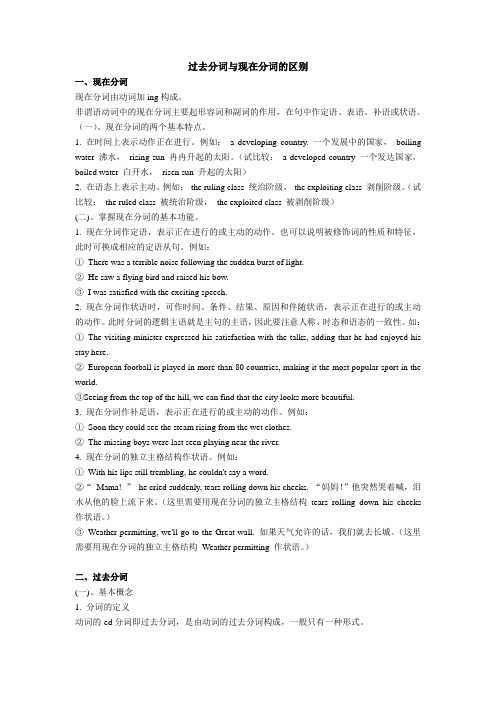
过去分词与现在分词的区别一、现在分词现在分词由动词加ing构成。
非谓语动词中的现在分词主要起形容词和副词的作用,在句中作定语、表语、补语或状语。
(一)、现在分词的两个基本特点。
1. 在时间上表示动作正在进行。
例如:a developing country. 一个发展中的国家,boiling water 沸水,rising sun 冉冉升起的太阳。
(试比较:a developed country 一个发达国家,boiled water 白开水,risen sun 升起的太阳)2. 在语态上表示主动。
例如:the ruling class 统治阶级,the exploiting class 剥削阶级。
(试比较:the ruled class 被统治阶级,the exploited class 被剥削阶级)(二)、掌握现在分词的基本功能。
1. 现在分词作定语,表示正在进行的或主动的动作。
也可以说明被修饰词的性质和特征,此时可换成相应的定语从句。
例如:①There was a terrible noise following the sudden burst of light.②He saw a flying bird and raised his bow.③I was satisfied with the exciting speech.2. 现在分词作状语时,可作时间、条件、结果、原因和伴随状语,表示正在进行的或主动的动作。
此时分词的逻辑主语就是主句的主语,因此要注意人称、时态和语态的一致性。
如:①The visiting minister expressed his satisfaction with the talks, adding that he had enjoyed his stay here.②European football is played in more than 80 countries, making it the most popular sport in the world.③Seeing from the top of the hill, we can find that the city looks more beautiful.3. 现在分词作补足语,表示正在进行的或主动的动作。
现在分词和过去分词的区别
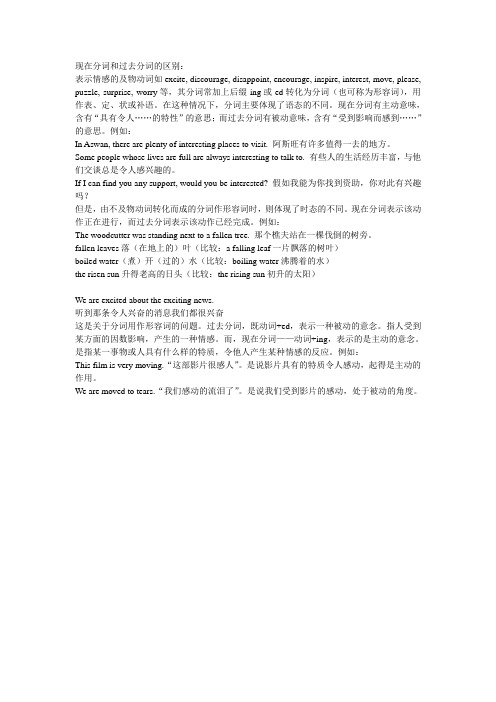
现在分词和过去分词的区别:表示情感的及物动词如excite, discourage, disappoint, encourage, inspire, interest, move, please, puzzle, surprise, worry等,其分词常加上后缀-ing或-ed转化为分词(也可称为形容词),用作表、定、状或补语。
在这种情况下,分词主要体现了语态的不同。
现在分词有主动意味,含有“具有令人……的特性”的意思;而过去分词有被动意味,含有“受到影响而感到……”的意思。
例如:In Aswan, there are plenty of interesting places to visit. 阿斯旺有许多值得一去的地方。
Some people whose lives are full are always interesting to talk to. 有些人的生活经历丰富,与他们交谈总是令人感兴趣的。
If I can find you any support, would you be interested? 假如我能为你找到资助,你对此有兴趣吗?但是,由不及物动词转化而成的分词作形容词时,则体现了时态的不同。
现在分词表示该动作正在进行,而过去分词表示该动作已经完成。
例如:The woodcutter was standing next to a fallen tree. 那个樵夫站在一棵伐倒的树旁。
fallen leaves落(在地上的)叶(比较:a falling leaf一片飘落的树叶)boiled water(煮)开(过的)水(比较:boiling water沸腾着的水)the risen sun升得老高的日头(比较:the rising sun初升的太阳)We are excited about the exciting news.听到那条令人兴奋的消息我们都很兴奋这是关于分词用作形容词的问题。
现在分词和过去分词的区别
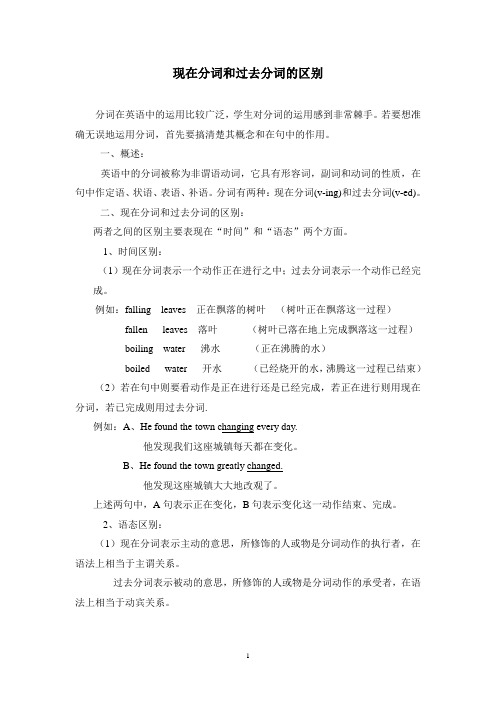
现在分词和过去分词的区别分词在英语中的运用比较广泛,学生对分词的运用感到非常棘手。
若要想准确无误地运用分词,首先要搞清楚其概念和在句中的作用。
一、概述:英语中的分词被称为非谓语动词,它具有形容词,副词和动词的性质,在句中作定语、状语、表语、补语。
分词有两种:现在分词(v-ing)和过去分词(v-ed)。
二、现在分词和过去分词的区别:两者之间的区别主要表现在“时间”和“语态”两个方面。
1、时间区别:(1)现在分词表示一个动作正在进行之中;过去分词表示一个动作已经完成。
例如:falling leaves 正在飘落的树叶(树叶正在飘落这一过程)fallen leaves 落叶(树叶已落在地上完成飘落这一过程)boiling water 沸水(正在沸腾的水)boiled water 开水(已经烧开的水,沸腾这一过程已结束)(2)若在句中则要看动作是正在进行还是已经完成,若正在进行则用现在分词,若已完成则用过去分词.例如:A、He found the town changing every day.他发现我们这座城镇每天都在变化。
B、He found the town greatly changed.他发现这座城镇大大地改观了。
上述两句中,A句表示正在变化,B句表示变化这一动作结束、完成。
2、语态区别:(1)现在分词表示主动的意思,所修饰的人或物是分词动作的执行者,在语法上相当于主谓关系。
过去分词表示被动的意思,所修饰的人或物是分词动作的承受者,在语法上相当于动宾关系。
例如:①a moving film.一部感人的影片。
(影片内容感动)= a film moves people.(主谓关系)S V②the moved students. 受感动的学生们= the Ss are moved by ……(动宾→宾语被置于主语的位置,采用被动的语态)S V(2)若在句中,则要看与全句的主语或其逻辑主语之间的关系,是主动用现在分词,若为被动,则要用过去分词。
现在分词与过去分词的区别

现在分词与过去分词的区别:1,语态上不同:现在分词表主动,而及物动词的过去分词表被动.2,时间关系上不同:现在分词表正在进行的动作,过去分词表示已经过去的动作.3,选用现在分词还是过去分词取决于分词所表示的动作与逻辑主语之间的时间关系.分词短语作状语,其逻辑主语是句子的主语.分词的形式:以vt:write和vi:go为例,1,现在分词:主动语态writing 被动语态being written 主动语态going2,过去分词: 只有一种形式 written gone现在分词和过去分词主要的区别表现在语态和时间关系上。
1)语态上不同:现在分词表示主动的意思,而过去分词多由及物动词变来,表示被动的意思。
试比较:surprising 使人感到惊讶的(主动)surprised 自己感到惊讶的(被动,即被惊讶的)an exciting story 一个令人兴奋的故事(主动)excited spectators 激动的观众(被动,即被引起激动的)a moving film 一部感动人的影片。
A moved audience 受感动的观众A tiring journey 累人的旅行A tired football player 累了的足球运动员He told us many interesting things last night.他昨夜告诉我们许多有趣的事情。
She is interested in astronomy. 她对天文学有兴趣。
也有一些过去分词是由不及物动词变来的,它们只表示一个动作已完成,没有被动的意味。
如:the risen sun 升起的太阳fallen leaves 落叶the exploded bomb 已爆炸了的炸弹a retired miner 退休矿工returned students 归国留学生2)时间关系上不同:一般说来,现在分词所表示的动作往往正在进行,而过去分词所表示的动作,往往已经完成。
现在分词与过去分词的区别与用法解析
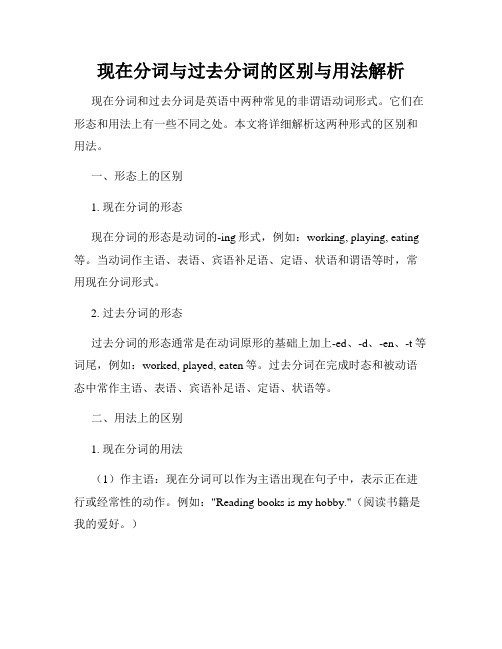
现在分词与过去分词的区别与用法解析现在分词和过去分词是英语中两种常见的非谓语动词形式。
它们在形态和用法上有一些不同之处。
本文将详细解析这两种形式的区别和用法。
一、形态上的区别1. 现在分词的形态现在分词的形态是动词的-ing形式,例如:working, playing, eating 等。
当动词作主语、表语、宾语补足语、定语、状语和谓语等时,常用现在分词形式。
2. 过去分词的形态过去分词的形态通常是在动词原形的基础上加上-ed、-d、-en、-t等词尾,例如:worked, played, eaten等。
过去分词在完成时态和被动语态中常作主语、表语、宾语补足语、定语、状语等。
二、用法上的区别1. 现在分词的用法(1)作主语:现在分词可以作为主语出现在句子中,表示正在进行或经常性的动作。
例如:"Reading books is my hobby."(阅读书籍是我的爱好。
)(2)作定语:现在分词可以修饰名词作定语,常表示主动、进行或经常性的动作。
例如:"The running water is very clear."(流动的水非常清澈。
)(3)作宾语补足语:现在分词可以作及物动词的宾语补足语,表示正在进行或经常性的动作。
例如:"I saw him painting the house."(我看见他正在刷房子。
)2. 过去分词的用法(1)作主语:过去分词可以作为主语出现在句子中,表示完成的动作或状态。
例如:"Broken glass covered the ground."(破碎的玻璃铺满了地面。
)(2)作定语:过去分词可以修饰名词作定语,表示被动或完成的动作。
例如:"The lost key has been found."(丢失的钥匙已经找到了。
)(3)作宾语补足语:过去分词可以作及物动词的宾语补足语,表示完成的动作或状态。
现在分词与过去分词的区别

现在分词与过去分词的主要区别现在分词和过去分词主要的区别表现在语态和时间关系上。
笔者想结合分词在定语、补语、状语及独立主格结构中的用法谈谈现在分词与过去分词的主要区别。
一、现在分词与过去分词当定语现在分词与过去分词当定语的区别首先表现在被修饰词与现在分词之间是主动关系,过去分词当定语时被修饰的词与分词之间则是被动关系。
单个分词作定语通常置于被修饰词之前,分词短语则要后置。
例如:The president made an inspiring speech(= which was inspiring)at the meeting.总统在会上作了令人鼓舞的演说。
The man sitting (= who is sitting) at the desk is his secretary. 坐在桌旁那个人是他的秘书。
The moved children (= who were moved) were determined to work harder at their lessons.受感动的孩子们决心更加努力地学习功课。
She showed me the book recommended by the professor (=which was recommended ).她把教授推荐的书给我看了看。
现在分词与过去分词当定语的另一个区别是现在分词表示动作正在进行,过去分词则表示动作已经完成。
例如:It is well known that China belongs to a developing country.众所周知,中国属于发展中国家。
We are determined to work harder so as to catch up with the developed countries.我们决心更加努力工作以便赶上发达国家。
不及物动词的过去分词只表示动作完成,没有被动含义。
I was watching the risen moon on the balcony when the telephone rang.我正在阳台上看升起了的月亮突然间电话铃响了。
现在分词和过去分词的用法区别
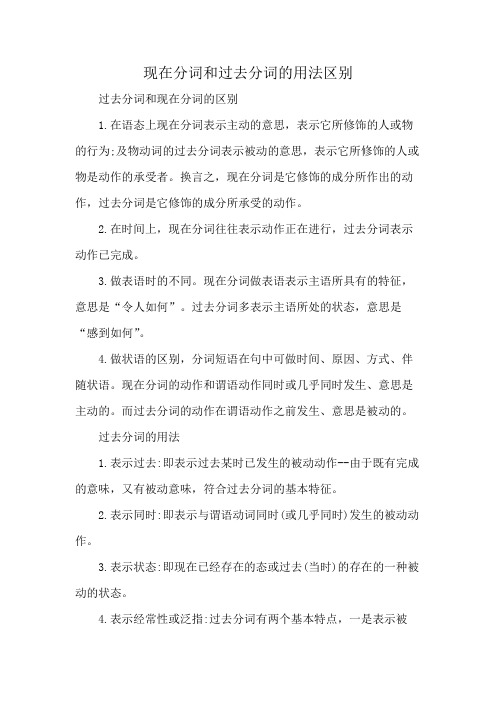
现在分词和过去分词的用法区别
过去分词和现在分词的区别
1.在语态上现在分词表示主动的意思,表示它所修饰的人或物的行为;及物动词的过去分词表示被动的意思,表示它所修饰的人或物是动作的承受者。
换言之,现在分词是它修饰的成分所作出的动作,过去分词是它修饰的成分所承受的动作。
2.在时间上,现在分词往往表示动作正在进行,过去分词表示动作已完成。
3.做表语时的不同。
现在分词做表语表示主语所具有的特征,意思是“令人如何”。
过去分词多表示主语所处的状态,意思是“感到如何”。
4.做状语的区别,分词短语在句中可做时间、原因、方式、伴随状语。
现在分词的动作和谓语动作同时或几乎同时发生、意思是主动的。
而过去分词的动作在谓语动作之前发生、意思是被动的。
过去分词的用法
1.表示过去:即表示过去某时已发生的被动动作--由于既有完成的意味,又有被动意味,符合过去分词的基本特征。
2.表示同时:即表示与谓语动词同时(或几乎同时)发生的被动动作。
3.表示状态:即现在已经存在的态或过去(当时)的存在的一种被动的状态。
4.表示经常性或泛指:过去分词有两个基本特点,一是表示被
动,二是表示完成。
现在分词的用法
1.现在分词的一般式所表示的动作与主语动作同时发生。
2.当要表示一个被动动作时,现在分词就用被动形式。
3.分词的否定式总是将否定词not置于分词之前,遇上现在分词的完成式、被动式以及完成被动式,否定词应置于整个结构之前。
现在分词与过去分词的差别
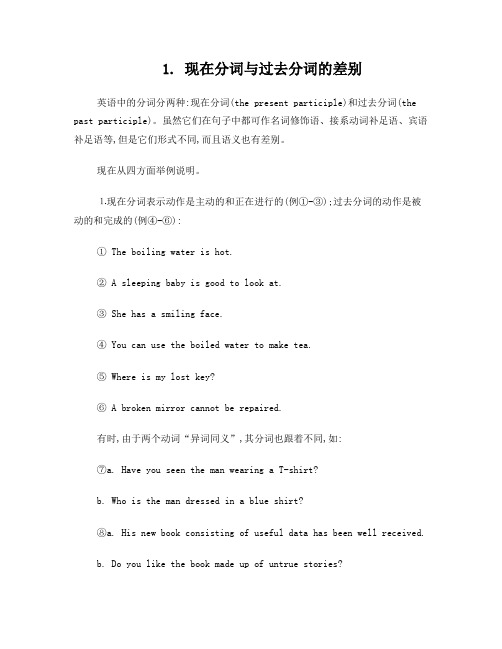
1. 现在分词与过去分词的差别英语中的分词分两种:现在分词(the present participle)和过去分词(the past participle)。
虽然它们在句子中都可作名词修饰语、接系动词补足语、宾语补足语等,但是它们形式不同,而且语义也有差别。
现在从四方面举例说明。
⒈现在分词表示动作是主动的和正在进行的(例①-③);过去分词的动作是被动的和完成的(例④-⑥):① The boiling water is hot.② A sleeping baby is good to look at.③ She has a smiling face.④ You can use the boiled water to make tea.⑤ Where is my lost key?⑥ A broken mirror cannot be repaired.有时,由于两个动词“异词同义”,其分词也跟着不同,如:⑦a. Have you seen the man wearing a T-shirt?b. Who is the man dressed in a blue shirt?⑧a. His new book consisting of useful data has been well received.b. Do you like the book made up of untrue stories?⒉在语义上,现在分词和过去分词反映的心理状态不同。
前者有“令人……”的含义(见例⑨);过去分词则有“感到……”的意思(见例⑩):⑨ The soccer match last night was thrilling.(令人紧张)⑩ The soccer fans were delighted.(感到高兴)其他例子有:● amazing: amazed● annoying: annoyed● boring: bored● confusing: confused● surprising: surprised● terrifying: terrified试比较11a和b以及12a和b:11a. This is the most confusing system I have ever seen.11b. The children will get confused if asked to learn too much at a time.12a. David came with some surprising news.12b. All were surprised at Sam’s sudden resignation.⒊在作宾语补足语时,如果宾语是有关分词逻辑上的主语,就用现在分词,如 :13. The teacher found a student dozing off.14. Don’t keep the visitor waiting.如果宾语和有关分词有“动词+宾语”关系,那么这个分词就要是过去分词了,如:15. Where did you get your book printed?16. You should have your office whitewashed.在13里,正在打瞌睡的是宾语“a studen t“;在14里,宾语是“the visitor”。
中考英语 现在分词和过去分词的区别

【小艺点睛】现在分词和过去分词的区别:在语态上,现在分词表示主动意义,过去分词表示被动意义;在时间上,现在分词表示的动作往往正在进行或者与谓语动词同时发生,过去分词表示的动作已经完成或没有一定的时间性。
如:falling leaves 正在下落的树叶fallen leaves 已经落在地上的树叶分词的作用1、作定语(1)单个分词作定语,分词前置。
如:The sleeping boy is my son.The excited people rushed into the building.(2)分词短语作定语,分词后置;分词修饰不定代词something等要后置;个别分词如give,left等作定语也后置。
如:The girl standing under the tree is my niece.The building built last year is our library.(3)过去分词作定语与其修饰的词是被动关系,相当于一个被动语态的定语从句。
如:Most of the people invited to the party were famous scientists.2、作状语现在分词和过去分词在句中可以作时间、原因、方式、伴随、条件、结果等状语。
Not receiving any letter from him, I gave him a call.(原因)Given more attention, the trees could have grown better. (条件)Bitten by a snake, he was taken to hospital. (原因)Though defeated, he didn’t lose heart. (让步)He lay on the grass, looking into the sky. (伴随)He came running to tell me the good news. (方式)注意:主要用于作状语,一般不用作定语。
过去分词与现在分词的区别

过去分词与现在分词的区别一、现在分词现在分词由动词加ing构成。
非谓语动词中的现在分词主要起形容词和副词的作用,在句中作定语、表语、补语或状语。
(一)、现在分词的两个基本特点。
1. 在时间上表示动作正在进行。
例如:a developing country. 一个发展中的国家,boiling water 沸水,rising sun 冉冉升起的太阳。
(试比较:a developed country 一个发达国家,boiled water 白开水,risen sun 升起的太阳)2. 在语态上表示主动。
例如:the ruling class 统治阶级,the exploiting class 剥削阶级。
(试比较:the ruled class 被统治阶级,the exploited class 被剥削阶级)(二)、掌握现在分词的基本功能。
1. 现在分词作定语,表示正在进行的或主动的动作。
也可以说明被修饰词的性质和特征,此时可换成相应的定语从句。
例如:①There was a terrible noise following the sudden burst of light.②He saw a flying bird and raised his bow.③I was satisfied with the exciting speech.2. 现在分词作状语时,可作时间、条件、结果、原因和伴随状语,表示正在进行的或主动的动作。
此时分词的逻辑主语就是主句的主语,因此要注意人称、时态和语态的一致性。
如:①The visiting minister expressed his satisfaction with the talks, adding that he had enjoyed his stay here.②European football is played in more than 80 countries, making it the most popular sport in the world.③Seeing from the top of the hill, we can find that the city looks more beautiful.3. 现在分词作补足语,表示正在进行的或主动的动作。
现在分词和过去分词的区别
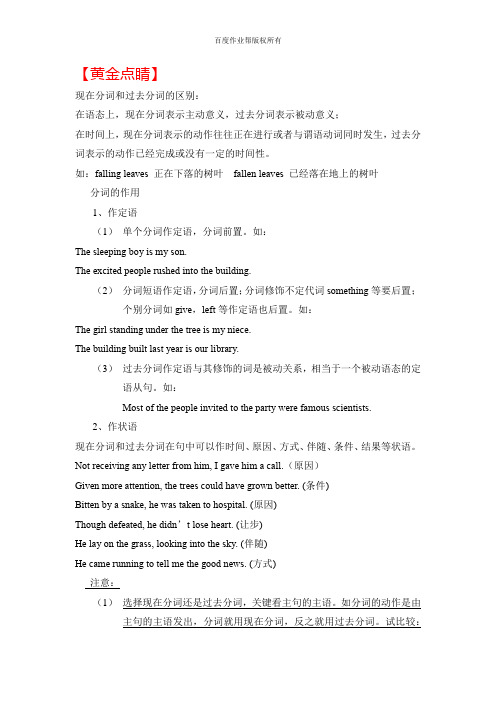
【黄金点睛】现在分词和过去分词的区别:在语态上,现在分词表示主动意义,过去分词表示被动意义;在时间上,现在分词表示的动作往往正在进行或者与谓语动词同时发生,过去分词表示的动作已经完成或没有一定的时间性。
如:falling leaves 正在下落的树叶fallen leaves 已经落在地上的树叶分词的作用1、作定语(1)单个分词作定语,分词前置。
如:The sleeping boy is my son.The excited people rushed into the building.(2)分词短语作定语,分词后置;分词修饰不定代词something等要后置;个别分词如give,left等作定语也后置。
如:The girl standing under the tree is my niece.The building built last year is our library.(3)过去分词作定语与其修饰的词是被动关系,相当于一个被动语态的定语从句。
如:Most of the people invited to the party were famous scientists.2、作状语现在分词和过去分词在句中可以作时间、原因、方式、伴随、条件、结果等状语。
Not receiving any letter from him, I gave him a call.(原因)Given more attention, the trees could have grown better. (条件)Bitten by a snake, he was taken to hospital. (原因)Though defeated, he didn’t lose heart. (让步)He lay on the grass, looking into the sky. (伴随)He came running to tell me the good news. (方式)注意:(1)选择现在分词还是过去分词,关键看主句的主语。
现在分词与过去分词的区别

3.分词作宾语补足语
现在分词在see, watch, hear, observe, notice, feel, find, glimpse, glance等感官动词和look at, listen to等短语动词以及have, keep, get, catch, leave, set, start, send等使役 动词后面与名词和代词构成复合宾 语,作宾语补语的成分。
A ,the museum will be open to the 4. When _ public next year. A. completed B. completing C. being completed D. to be completed B to his research, he almost forgot 5. _ everything. A. Devoting B. Devoted C. To devote D. Devote
例如
1、On the top of the hill, we could see smoke rising from the chimneys in the village. 2、The boy sat beside the railway line and watched the trains roaring by. 3、We should not leave him wondering what he should do. 4、I am sorry to have kept you waiting for such a long time. 5、I caught him doing something else in class.
◆ The result of the test is
动词的现在分词与过去分词的区别
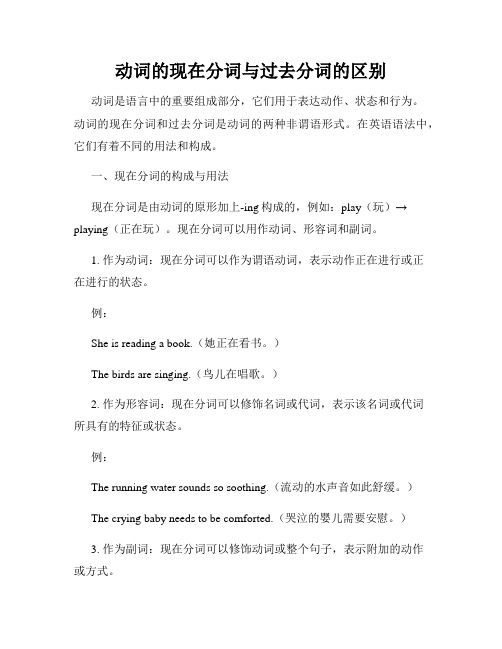
动词的现在分词与过去分词的区别动词是语言中的重要组成部分,它们用于表达动作、状态和行为。
动词的现在分词和过去分词是动词的两种非谓语形式。
在英语语法中,它们有着不同的用法和构成。
一、现在分词的构成与用法现在分词是由动词的原形加上-ing构成的,例如:play(玩)→ playing(正在玩)。
现在分词可以用作动词、形容词和副词。
1. 作为动词:现在分词可以作为谓语动词,表示动作正在进行或正在进行的状态。
例:She is reading a book.(她正在看书。
)The birds are singing.(鸟儿在唱歌。
)2. 作为形容词:现在分词可以修饰名词或代词,表示该名词或代词所具有的特征或状态。
例:The running water sounds so soothing.(流动的水声音如此舒缓。
)The crying baby needs to be comforted.(哭泣的婴儿需要安慰。
)3. 作为副词:现在分词可以修饰动词或整个句子,表示附加的动作或方式。
例:He came running to catch the bus.(他跑着过来赶公交车。
)Considering the circumstances, I think we made the right decision.(考虑到情况,我认为我们做出了正确的决定。
)二、过去分词的构成与用法过去分词是由动词的原形加上-ed、-d、-t、-en或常见的不规则变化形式构成的,例如:play(玩)→ played(玩过了)。
过去分词可以用作动词、形容词和副词。
1. 作为动词:过去分词可以表示过去的动作或状态,常与助动词have或be连用,构成完成时态或被动语态。
例:They have finished their homework.(他们完成了作业。
)The house was built in 1990.(房屋建于1990年。
)2. 作为形容词:过去分词可以修饰名词或代词,表示由该名词或代词引起的动作或状态。
现在分词和过去分词的用法区别
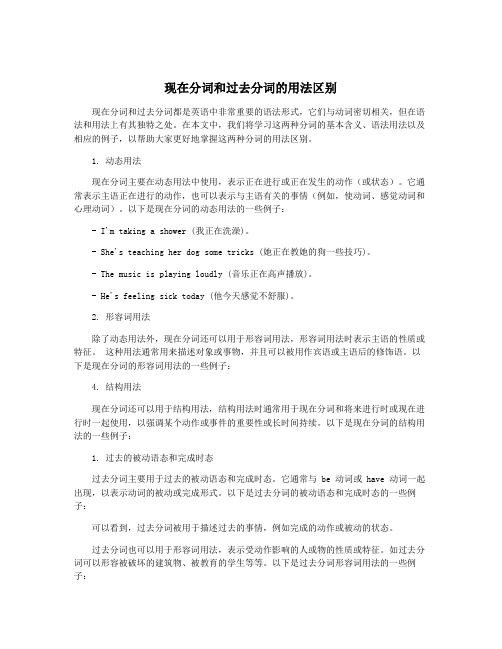
现在分词和过去分词的用法区别现在分词和过去分词都是英语中非常重要的语法形式,它们与动词密切相关,但在语法和用法上有其独特之处。
在本文中,我们将学习这两种分词的基本含义、语法用法以及相应的例子,以帮助大家更好地掌握这两种分词的用法区别。
1. 动态用法现在分词主要在动态用法中使用,表示正在进行或正在发生的动作(或状态)。
它通常表示主语正在进行的动作,也可以表示与主语有关的事情(例如,使动词、感觉动词和心理动词)。
以下是现在分词的动态用法的一些例子:- I'm taking a shower (我正在洗澡)。
- She's teaching her dog some tricks (她正在教她的狗一些技巧)。
- The music is playing loudly (音乐正在高声播放)。
- He's feeling sick today (他今天感觉不舒服)。
2. 形容词用法除了动态用法外,现在分词还可以用于形容词用法,形容词用法时表示主语的性质或特征。
这种用法通常用来描述对象或事物,并且可以被用作宾语或主语后的修饰语。
以下是现在分词的形容词用法的一些例子:4. 结构用法现在分词还可以用于结构用法,结构用法时通常用于现在分词和将来进行时或现在进行时一起使用,以强调某个动作或事件的重要性或长时间持续。
以下是现在分词的结构用法的一些例子:1. 过去的被动语态和完成时态过去分词主要用于过去的被动语态和完成时态。
它通常与 be 动词或 have 动词一起出现,以表示动词的被动或完成形式。
以下是过去分词的被动语态和完成时态的一些例子:可以看到,过去分词被用于描述过去的事情,例如完成的动作或被动的状态。
过去分词也可以用于形容词用法,表示受动作影响的人或物的性质或特征。
如过去分词可以形容被破坏的建筑物、被教育的学生等等。
以下是过去分词形容词用法的一些例子:3. 补语用法过去分词还可以用作补语,它是某些及物动词的现在分词形式,并在表达被动语态时使用,通常作为系动词 be 的补语。
现在分词与过去分词的区别

A. drink B. to drink C. drinking D. drunk
20.I appreciated ________ the opportunity to study abroad two years ago.
Not knowing what to do, he went to his parents for help.
由于不知如何办是好,他去找父母帮忙。
Smiling, they came in.
2)过去分词作状语时,过去分词表示的动作是句子主语承受的动作,它们之间的关系是被动关系。
9.He is an ________ teacher.
A. advancing B. advanced C. being advancing D. advance
10.________ exceptions, the rule may stand.
A. Allow for B. Allowing for C. To allow D.To allow for
Travelling is interesting but tiring.旅行是有趣的,但是使人疲劳。
The pupils will get confused if they are made to learn too much.
如果要学生学得太多,他们会感到糊涂的。
The game is exciting. (现在分词作表语)
8.The bank is reported in the local newspaper ________ in broad daylight yesterday.
- 1、下载文档前请自行甄别文档内容的完整性,平台不提供额外的编辑、内容补充、找答案等附加服务。
- 2、"仅部分预览"的文档,不可在线预览部分如存在完整性等问题,可反馈申请退款(可完整预览的文档不适用该条件!)。
- 3、如文档侵犯您的权益,请联系客服反馈,我们会尽快为您处理(人工客服工作时间:9:00-18:30)。
现在分词和过去分词的区别:两种分词的区别很多,但它们之间的根本区别是:1.语态上不同:现在分词在语态上表示主动;而及物动词的过去分词表示被动。
2.时间关系上不同:现在分词在时态上强调动作正在进行;过去分词在时态上强调动作已经完成这种根本的区别具体体现在两种分词分别充当的各种句子成份中。
细述如下:一、分词作定语共同点:分词作定语时,如果分词只是一个单词,那么,该分词就位于其所修饰的名词之前;如果是分词短语,那么,该短语就位于其所修饰的名词之后,它的作用相当于一个定语从句。
不同点:分词作定语时,被分词所修饰的名词就是该分词的逻辑主语。
但现在分词与逻辑主语之间是主动关系,所表示的动作一般与句中谓语动词所表示的动作同时发生;而过去分词则表示被动关系,所示动作一般发生在谓语动词之前或同时发生。
1. There was a terrible noise ____ the sudden burst of light.A. followedB. followingC. to be followedD. being followed简析:首先,根据语法分析可知,句子后半部分是一个作定语、修饰noise 的分词短语;再根据句意“一阵闪电之后,接着就是一声巨响。
”可知,巨响应是主动,紧接在闪电之后的。
因此,该题应选________?2. The Olympic Games, ____ in 776 B. C., didn’t include women until 1912.A. first playingB. to be first playedC. first playedD. to be playing简析:首先,根据语法分析可知,待选部分是一个作定语、修饰The Olympic Games 的后置分词短语;再根据The Olympic Games 对于动词play 来说只能是被动承受,且已完成(in 776 B. C.)。
因此,该题应选_______?3. What’s the language ____ in Germany?A. speakingB. spokenC. be spokenD. to speak简析:测试过去分词作后置定语表达被动,等于定语从句which is spoken; 因此答案是_________?4. Most of the people ____ to the party were famous scientists.A. invitedB. to inviteC. being invitedD. inviting简析:首先,根据语法分析可知,待选部分是一个作定语; 再看people 和invite to the party 是被动关系,即被邀请来参加晚会的人,等于定语从句who were invited,因此答案应该是______?5. Most of the artists ____ to the party were from South Africa.A. invitedB. to inviteC. being invitedD. had been invited6. The computer centre, ____ last year, is very popular among the students in this school.A. openB. openingC. having openedD. opened7. The first textbooks ____ for teaching English as a foreign language came out in the 16th century.A. having writtenB. to be writtenC. being writtenD. written二、分词作表语共同点:现在分词和过去分词作表语时,都起着形容词的作用。
不同点:现在分词作表语时,与其逻辑主语之间是主动关系,所表示的动作的一般与句中谓语动词所表示的动作同时发生;而过去分词则表示被动关系,所示动作一般发生在谓语动词之前或同时发生。
1. This news sounds ____.A. encouragingB. encouragedC. encouragesD. to encourage2. -How did Bob do in the exams this time?-Well, his father seems ____ with his results.A. pleasingB. pleaseC. pleasedD. to please3. -How did the audience receive the new play?-They got very ____.A .excite B. excited C .excitedly D .exciting三、分词作宾语补足语共同点:分词作宾语补足语时,句子的宾语就是该分词的逻辑主语。
两种分词在复合宾语中作宾语补足语时,都是对句子的宾语起补充或说明作用。
不同点:但现在分词与其逻辑主语之间是主动关系,所表示的动作一般与句中谓语动词所表示的动作同时发生;而过去分词则表示被动关系,所示动作一般发生在谓语动词之前或同时发生。
Eg: 1. The next morning she found the man ____ in bed, dead.A. lyingB. lieC. layD. laying2. ----Good morning. Can I help you?----I’d like to have the package ____, madam.A. be weighedB. to be weighedC. to weighD. weighed3. If you wave your book in front of your face, you can feel the air ________ against your face.A. movedB. movingC. movesD. to move四、分词作状语共同点:过去分词和现在分词作状语时,句子的主语就是该分词的逻辑主语。
一般都在句子中作时间、原因、方式或伴随等状语。
不同点:但现在分词作状语时,与其逻辑主语之间是主动关系,所表示的动作一般与句中谓语动词所表示的动作同时发生;而过去分词则表示被动关系,所示动作一般发生谓语动词之前发生。
Eg:1. European football is played in 80 countries, ____ it the most popular sport in the world.A. makingB. makesC. madeD. to make简析:首先,根据语法分析可知,待选部分在整个句中应作状语;再根据European football 对于make 来说应是主动关系,即欧洲足球使之本身成为一项最受世人欢迎的运动。
因此,该题应选_____?。
2.____ a reply, he decided to write again.A. Not receivingB. Receiving notC. Not having receivedD. Having not received3. The visiting Minister expressed his satisfaction with the talks, ____ that he had enjoyed his stay here.A. having addedB. to addC. addingD. added4. “Can’t you read?” Mary said ____ to the not ice.A. angrily pointingB. and point angrilyC. angrily pointedD. and angrily pointing简析:测试现在分词作伴随状语,通过副词angrily 进行干扰。
Mary 和point 之间是主动关系,因此答案该题应选_______?More practice:1. _________ more attention, the tree could have grown better. (90’全国)A. GivenB. To giveC. GivingD. Having given.2. The computer center, _________ last year, is very popular among the students in this school. (93’全国)A. openB. openingC. having openedD. opened3. The first textbooks _________ for teaching English as a foreign language came out in the 16thcentury. (94’全国)A. having writtenB. to be writtenC. being writtenD. written4. _________ in thought, he almost ran into the car in front of him. (96’全国)A. LosingB. Having lostC. LostD. To lose5. ______ in 1636, Harvard is one of the most famous universities in the United States. (00’上海)A. Being foundedB. It was foundedC. FoundedD. Founding6. When _________, the museum will be open to the public next year. (02’上海春)A. completedB. completingC. being completedD. to be completed7. Prices of daily goods _______ through a computer can be lower than store prices. (02’京皖春)A. are boughtB. boughtC. been boughtD. buying8. Don’t use words, expressions, or phrases _________only to people with specific knowledge. (02’上海)A. being knownB. having been knownC. to be knownD. known9. Unless _________ to speak, you should remain silent at the conference. (03’上海春)A. invitedB. invitingC. being invitedD. having invited10. Friendship is like money: easier made than _________. (03’北京)A. keptB. to be keptC. keepingD. having kept11. _________ time, he’ll make a first-class tennis player. (03’北京)A. Having givenB. To giveC. GivingD. Given12. Climbing mountains was ____, so we all felt ____.A. tiring ; tiredB. tired ; tiringC. tiring ; tiringD. tired ; tired13. The ____ morning, the father came into the lonely house, ____ by his naughty boy.A. following ; followingB. followed ; followedC. following ; followedD. followed ; following14. _______ these pictures, I couldn’t help thinking of those days when I was in Beijing and ____ from the top of a thirty-storeyed building, Beijing looks more magnificent.A. Seeing; seenB. Seen ; seeingC. Seeing ; seeingD. Seen ; seen15. Mrs. White was glad to see the nurse ____ after her son and her daughter and was alsopleased to see children well ____ care of in the nursery.A. looked ; takenB. looking ; takenC. looked ; tookD. looking; taking16. I was lucky to pick up a wallet ____ on the ground on the way home, but unfortunately forme, I found my color TV set ____ when I got home.A. lying; stolenB. laying; stealingC. lay; stolenD. lying; stealing17. _______ better attention, the vegetables could have grown better with the sun shiningbrightly in the sky and ____ them light.A. Giving; givenB. Given; givenC. Giving; givingD. Given; giving18. ____ his head high, the manager walked into the room to attend the meeting ____ then.A. Holding; being heldB. Held ; holdingC. Having held ; heldD. Held ; to be held19. ________ but he still could not understand it.A. Told many timesB. Having been told many timesC. He has been told many timesD. Though he had been told many times20. On hearing the ____ news, I was too ____ to sleep.A. exciting; excitedB. excited; excitingC. exciting; excitingD. excited; excited21. When I put my hand on his chest, I could feel his heart still ____.A. beatB. beatingC. beatenD. to beat22. When I went home, I saw a letter on the desk ____ “Dinner is ready. Mommy”A. saysB. sayingC. writtenD. writing23. The manager promised to keep me ________of how our business was going on.A. to be informedB. on informingC. informedD. informing24. The speaker, ________for her splendid speeches, was warmly received by the audience.A.having knownB. being knowingC. knowingD. known25. Returning to the room, _______.A. the book was lostB. I found the book missingC. the book was missingD. the book was found missingReading the following passage and think it carefully? What food for thought can you get?Like most big projects, learning to manage your mother well is important. Here are what I believe the best steps towards a better relationship with her. They are not necessarily surprising, but they have worked for many people. Try them.Remember your mother’s age. Knowing our mothers’ age , not just in numbers of years but in terms of her psychological and physical state, often helps to understand her better.Listen to your mother. As we grow up, what our mother has told us sounds of no use for the world we live in today. Yet I have found that sometimes her words from long time ago are very useful. If your mother knows that you respect her point of view, even if you don’t share it, it will help her feel close to you.Ask your mother about your childhood history. If you are fortunate enough to have a living family., think of your life as a jigsaw(拼图) puzzle and ask as many questions as you can to put the picture together. Understanding your roots and your childhood can help you know more clearly who you are and to be a part of a family which you share with your mother.Remember that managing your mother is really about managing yourself. No matter how difficult we find her, it is important to remember that ti is not her behavior itself that is causing us discomfort, but the way we feel about her behavior. We should follow the way of her life. Only then can you accept your mother—with her all her failings (缺点)。
